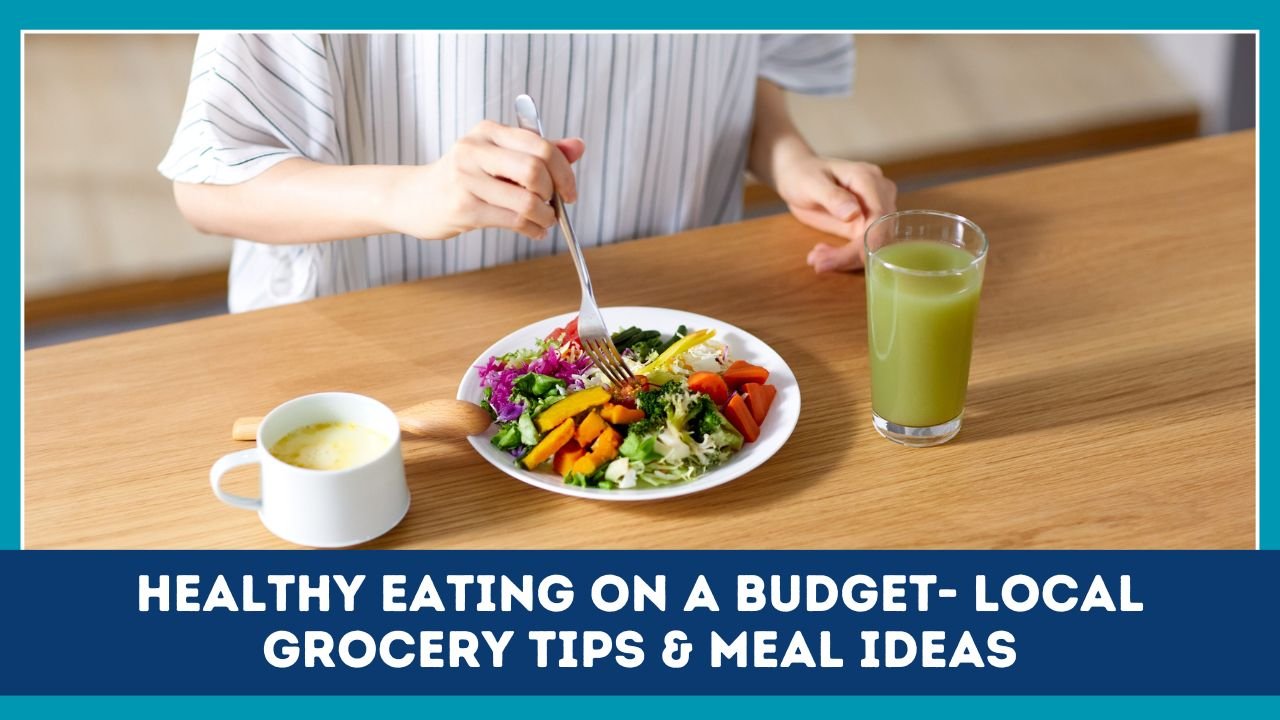Eating healthy often feels like it comes with a higher price tag, especially when grocery bills keep climbing. But the truth is, with smart planning, careful shopping, and creative meal ideas, you can eat nutritious, filling meals without overspending.
This guide will give you everything you need to know about healthy eating on a budget in 2025, including grocery shopping strategies, cost-saving swaps, pantry essentials, and budget-friendly meal plans.
Why Healthy Eating Feels Expensive
Many people believe that eating healthy costs more, and while it’s true that fresh produce, lean meats, and specialty health items can be pricey, there are several reasons why food budgets feel tight:
- Inflation: Prices for staples like bread, eggs, and vegetables have risen steadily.
- Convenience factor: Pre-packaged and pre-cut foods save time but cost much more.
- Marketing traps: Labels like “organic,” “superfood,” or “all-natural” often push prices up even if healthier alternatives exist at lower cost.
- Waste: Buying more than you can finish—especially perishable fruits and vegetables—leads to spoiled food and wasted money.
The good news? With a clear strategy, you can shop smarter, cook efficiently, and reduce waste, making healthy meals affordable again.
Budget-Friendly Grocery Shopping Strategies
Here are the best ways to shop smart and stretch your dollar without sacrificing health:
1. Make a Weekly Meal Plan
Instead of shopping without a plan, map out your meals for the week. A simple 7-day outline helps you buy only what you need and prevents random, expensive purchases.
2. Shop Sales and Discounts
Start your planning by looking at your local grocery store’s flyers or apps. Build meals around what’s on sale—like chicken thighs, apples, or frozen vegetables.
3. Compare Unit Prices
Always check the unit price (price per ounce, pound, or gram). Bigger packages aren’t always cheaper.
4. Buy Store Brands
Generic or store-brand products often cost less while offering the same nutrition as name brands. Pantry staples like oats, beans, and canned tomatoes are perfect store-brand buys.
5. Use Frozen and Canned Foods
Frozen vegetables and fruits are often cheaper than fresh, last longer, and are just as nutritious. Choose no-salt canned beans or tomatoes for affordable meal building.
6. Shop Seasonally
Buy produce that’s in season. Seasonal fruits and vegetables are cheaper, fresher, and tastier than out-of-season imports.
7. Don’t Shop Hungry
Impulse buys spike when you shop on an empty stomach. Eat before you shop to stay focused on your list.
Build a Budget-Smart Pantry
A well-stocked pantry is the secret weapon for budget-friendly, healthy meals. These items provide the foundation for dozens of recipes without breaking the bank.
1. Affordable Proteins
- Dry beans (black, pinto, chickpeas)
- Lentils
- Eggs
- Canned tuna or salmon
- Chicken thighs
- Peanut butter
- Greek yogurt
2. Whole Grains and Starches
- Brown rice
- Oats
- Whole-wheat pasta
- Corn tortillas
- Potatoes and sweet potatoes
3. Vegetables and Fruits That Last
- Carrots, onions, cabbage, and garlic
- Winter squash
- Apples and oranges
- Frozen spinach, broccoli, and peas
- Frozen berries and mango
4. Healthy Fats and Flavor Builders
- Olive oil or canola oil
- Sunflower seeds, chia seeds (small amounts go far)
- Canned tomatoes and paste
- Dried herbs and spices
- Vinegar and soy sauce
Smart Swaps That Save Money
| Expensive Option | Budget-Friendly Swap | Why It Works |
|---|---|---|
| Fresh salmon fillets | Canned salmon or tuna | Cheaper, long shelf life, still high in protein and omega-3s |
| Pre-cut salad kits | Whole heads of cabbage or lettuce | Last longer, less packaging, lower cost |
| Chicken breast | Chicken thighs or drumsticks | More affordable, flavorful, versatile |
| Fresh berries out of season | Frozen berries | Cheaper year-round, nutrient-rich, less waste |
| Flavored single-serve yogurt | Large tub of plain yogurt + fruit | Lower cost per serving, customizable flavors |
| Bottled smoothies | Homemade fruit + spinach smoothie | Healthier, fresher, and far cheaper |
| Snack bars | Oats + peanut butter + honey bites | DIY snacks for pennies |
A Week of Budget-Friendly Meal Ideas
Planning ahead is key. Here’s a weekly rotation that uses affordable ingredients and minimizes waste.
1. Breakfasts
- Overnight oats with frozen berries and peanut butter
- Veggie omelet with onions and spinach
- Greek yogurt parfait with oats and diced apple
2. Lunches
- Bean burrito bowls with rice, beans, salsa, and cabbage
- Tuna and white bean salad with lemon dressing
- Lentil soup with carrots, onion, and canned tomatoes
3. Dinners
- Sheet-pan chicken thighs with potatoes and carrots
- Chickpea curry with coconut milk and rice
- Pasta with chickpeas and spinach
- Fried rice with leftover rice, egg, and mixed vegetables
- Turkey and bean chili with cabbage slaw
4. Snacks
- Apples or oranges
- Popcorn
- Carrots and hummus
- Peanut butter on toast
- Hard-boiled eggs
3-Day Meal Plan Example (Family of 2 Adults)
| Day | Breakfast | Lunch | Dinner | Prep Notes |
|---|---|---|---|---|
| Monday | Overnight oats | Burrito bowl | Sheet-pan chicken | Bake extra chicken for Wednesday |
| Tuesday | Omelet + toast | Tuna-white bean salad | Chickpea curry + rice | Cook extra rice for Thursday |
| Wednesday | Yogurt parfait | Lentil soup | Pasta with chickpeas + chicken | Use Monday’s chicken leftovers |
Cutting Food Waste = Cutting Costs
A major hidden expense in healthy eating is food waste. Here’s how to reduce it:
- First In, First Out (FIFO): Rotate older items to the front of your fridge/pantry.
- Freeze extras: Leftover rice, soups, or bread can be frozen and used later.
- Repurpose scraps: Turn broccoli stems into slaw, stale bread into croutons, carrot tops into pesto.
- Use a “must-eat” bin: Keep a small container in your fridge for items that need to be eaten within 48 hours.
Mastering Protein on a Budget
Protein is often the costliest part of a meal. To save:
- Eggs: Versatile and affordable.
- Beans and lentils: Inexpensive, filling, and fiber-rich.
- Canned fish: Pantry-stable with excellent nutrition.
- Greek yogurt and cottage cheese: Affordable high-protein snacks.
- Meat-and-bean blends: Stretch ground meat by mixing with beans or lentils for tacos, chili, or pasta sauce.
Quick Meal Prep Hacks
Healthy eating only works if you actually have time to cook. Save hours with these hacks:
- Cook once, eat twice: Double-batch grains, beans, or proteins and reuse in different meals.
- One-pot meals: Soups, curries, and stir-fries are quick, cheap, and minimize cleanup.
- Simple sauces: Yogurt-garlic, tahini-lemon, or soy-ginger instantly upgrade plain ingredients.
- Neutral seasoning base: Cook proteins and grains with simple spices so you can reuse them in different cuisines (e.g., tacos one night, curry the next).
Eating Out Without Blowing the Budget
Sometimes dining out is unavoidable. Here’s how to stay healthy and save:
- Share entrées: Restaurant portions are often big enough for two.
- Skip drinks: Water is free and avoids the 20% price hike from sodas or juices.
- Pack leftovers: Turn half a restaurant meal into lunch for the next day.
Healthy eating on a budget is not only possible—it’s practical, rewarding, and completely achievable for any household. The key lies in understanding that you don’t need to buy the most expensive organic produce or specialty health products to nourish yourself well.
By shifting your mindset to strategic planning, smart grocery shopping, and creative cooking, you can maximize both your nutrition and your money.
Think of your grocery cart as your toolbox. When you shop smarter, you fill it with the items that work hardest for you—beans, rice, eggs, frozen vegetables, oats, canned fish, and seasonal produce. These staples can be turned into dozens of satisfying meals without stretching your budget thin.
Embracing store brands, buying in bulk when appropriate, and relying on frozen or canned options when fresh items are overpriced helps keep your weekly bill steady and predictable.
The real secret to making healthy eating affordable is planning ahead. Creating a simple meal plan keeps you focused, prevents unnecessary purchases, and ensures that nothing goes to waste.
Cooking at home, even just a few extra nights each week, not only saves money but also puts you in control of your ingredients, portion sizes, and long-term health. Over time, this planning builds habits that save hours, dollars, and stress.
Another often-overlooked part of budget-friendly healthy eating is reducing food waste. Every apple that spoils in your fridge or half a loaf of bread that gets thrown out is money gone.
By freezing leftovers, using a “must-eat-soon” box in your fridge, and repurposing scraps into soups, smoothies, or snacks, you stretch your dollars further and respect the value of your food.
Healthy eating on a budget is not about restriction—it’s about empowerment and resourcefulness. It teaches you to look at ingredients differently, to discover new ways of preparing familiar foods, and to enjoy meals that are simple yet nourishing.
Over time, these practices make you feel more in control of your health and finances.
Remember, every dollar saved on groceries can go toward other essentials like rent, savings, or family needs, while every home-cooked meal is an investment in your long-term well-being. Eating well doesn’t have to mean spending more—it means spending wisely.
With the grocery tips, pantry staples, smart swaps, and meal ideas shared in this guide, you now have a blueprint for success. You can confidently say: healthy eating is affordable, sustainable, and within reach for everyone—no matter your budget.
FAQs
Can you really eat healthy on a tight budget?
Yes. By focusing on pantry staples like beans, rice, oats, eggs, and frozen vegetables, you can prepare meals that are both affordable and nutritious. The key is planning and reducing waste.
What’s the cheapest source of protein?
Beans, lentils, and eggs are the most affordable. Pairing beans with rice also provides a complete protein, making it a powerful budget meal.
Is frozen food as healthy as fresh?
Yes. Frozen fruits and vegetables are often harvested at peak ripeness and flash-frozen, preserving nutrients. They’re affordable, long-lasting, and reduce waste.

